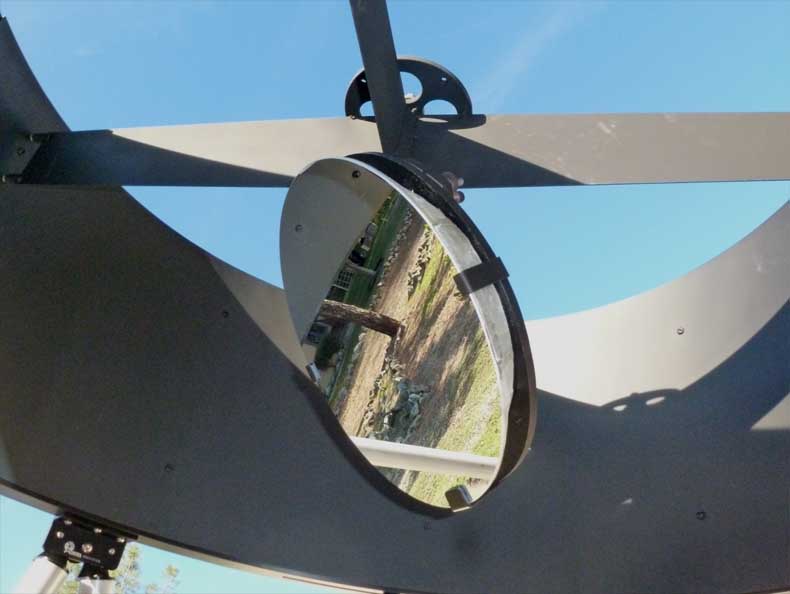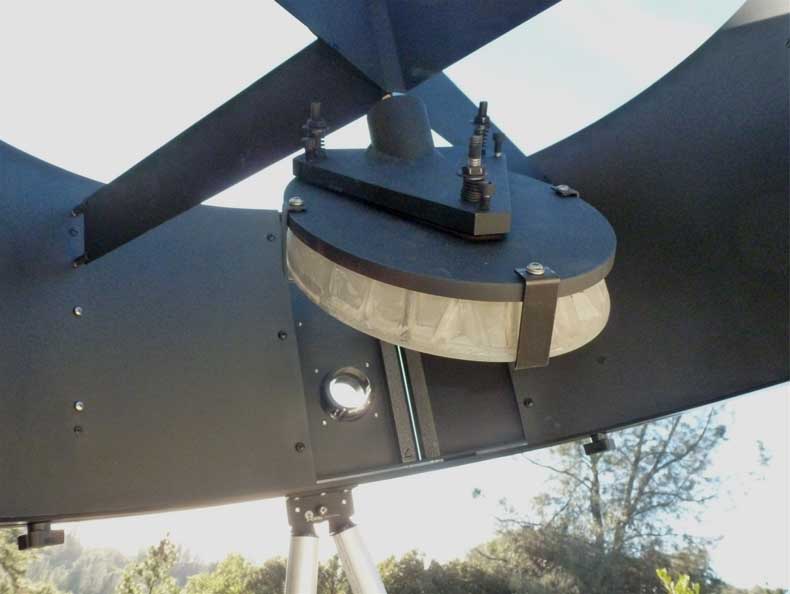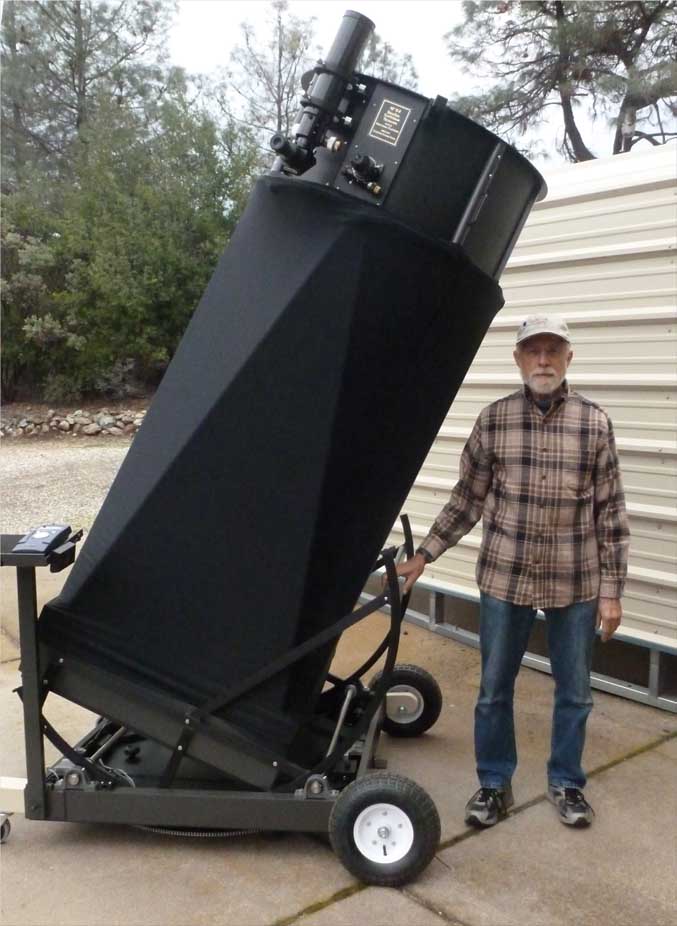| 2)
INSTALLING THE OPTICS
What
can one expect, performance-wise, with an f2.8 Newtonian
system? This was the question rattling around in the back
of my mind during the year spent constructing the telescope
and waiting for the optics. I had read some of the reports
from Mike Lockwood and others about the performance of his
ultra-short mirrors, but had never used one myself, so I
retained a bit of skepticism.
One
day, the primary mirror arrived, encased in an incredibly
sturdy wooden crate (thanks Mike!). The mirror cell which
was waiting for the 32" primary is a welded and powdercoated
steel structure made from 1" square tubing. The back
support for the mirror is a low profile 18 point flotation
setup with stainless steel triangles. Two rocker arms carry
the 4-point edge support. The whole cell, with mirror, swivels
at its base when moved with the two large brass collimation
knobs.
|
| These
knobs are near the top of the mirror box and easily
accessible even with the scope pointed at the zenith.
The three cooling fans in the back of the cell come
with an adjustable speed control.
For
the large 8" secondary, the owner of this telescope
chose a lightweight cellular mirror which was provided
by Mike Lockwood. When it arrived, this mirror proved
indeed to be quite light in weight compared to a similar
sized monolithic piece of glass. It was mounted onto
a custom holder made by Randy Cunningham at AstroSystems.
Because of the shape of the diagonal, it had to be
glued onto the holder's face plate, something I have
always been leery of doing. It seemed especially dicey
for a mirror of this size.
Still, it was the only option. The back of the mirror
is not a solid piece of glass, but there were three
obvious places to put spots of silicon glue. In the
end, it turned out quite well and the mirror does
not show any sign of being distorted by causing warped
or astigmatic images. There are three clips on the
holder that will restrain the glass only if there
is a failure of the glue. The plate that the diagonal
is attached to is adjusted in tilt by three spring-loaded
screws mounted to a second smaller plate. This works
very well and it is easy to precisely adjust the mirror
for collimation. The 4-vane spider that Randy also
provided is super heavy duty. Once the vanes are tightened
with two 1/4" bolts apiece, the rigidity of the
whole assembly leaves nothing to be desired.
|
 |
|
 |
|
3)
COLLIMATION and FIRST LIGHT
So,
the mirrors were installed and then on the next clear night
the telescope was rolled out from my shop to the observing
site. The scope was then raised off its wheels and leveled
to the ground by shimming up the three feet on the bottom
of the groundboard as needed.
Next
came collimation of the optics. This proved to be a snap
with my Glatter laser. When it got dark, I tuned up the
collimation a tad using an out of focus star. The movement
of both the primary collimation knobs and the secondary
screws is on the stiff side, so once an adjustment is made,
it stays there. There is no slack or looseness.
Once the optics were collimated and the tracking engaged,
we were ready for First Light! The moment of truth had come
- how would this large fast mirror perform?
My observing partner for this occasion was noted astro-imager
(and avid visual observer), Tony Hallas.
Our
first object was Vega, since it was the brightest star in
the twilight sky. The seeing was pretty good, as it often
is early in the evening, before our foothill air gets turbulent
when darkness settles. A 7mm Pentax XW eyepiece was put
into the Type II Paracorr giving about 375x. Vega focused
down to a blinding point of light. There was no question
when you were in focus. It just snapped in. Both inside
and outside of focus, sharp and contrasty diffraction rings
were visible. They were almost identical. This surprised
me! With fast mirrors I was used to seeing diffraction rings
on one side of focus (usually outside of focus), but just
mush and spikiness on the other side. But not with this
mirror. One thing working in our favor was that the mirror
was pretty much cooled down at the time since the scope
had been in my shop all day, instead of out in the hot sun.
As
darkness settled, we moved from one thing to another quickly
in order to get some views in of various objects before
the seeing inevitably worsened as the evening progressed.
First object was M13, fairly low in the west. Nice view
at 370x, considering its low altitude and the crescent moon
nearby. Thousands of stars filled the field. They were tiny,
discreet pinpoints of light, a testament to the sharp focus
this mirror was producing.
Next
we went to the Ring Nebula, which was higher up and well
placed for a good view. And a good view it was! First at
380x. Then at 880x. At that high power it dominated the
field of view. While the seeing was now starting to go downhill,
the central star was still visible, sometimes with direct
vision when the seeing sharpened up. This was with a so-so
suburban sky (Milky Way visible, but not spectacular) and
a crescent moon. Also to be noted, the tracking at that
high power was excellent, with no vibration or shaking.
Using the hand control at the lowest slew rate I could glide
that huge image of the Ring to the center of the field with
no difficulty. Then I did Go-To's to various other objects
like the Dumbbell, the CatsEye, the Double Cluster and NGC
891. The scope quickly found every object in a 260x field
of view.
We
used a Paracorr II throughout the session, mostly with my
higher power Pentax XW's (10mm and 7mm) and Tony's Delos
eyepieces. The highest power of 880x was achieved with a
3mm Radian. But I also wanted to test the sharpness, especially
the edge sharpness, with a lower power. So I put in a 20mm
Nagler Type5, which, with the Paracorr, produced 132x with
a 2/3 degree field of view. Stars were pinpoints right out
to the edge of the field! Yes! So much for worries about
the coma of an f2.8 focal ratio. The fabulous Type II Paracorr
just ate it up.
4)
CONCLUSION
Suffice
to say for now that we were frankly stunned by the telescope's
performance, both mechanically and optically. We did not
expect to see the kind of images this f2.8 mirror delivered.
Tony, especially, is wary of shorter mirrors. For the 24"
SlipStream Telescope that I built for him, he did not even
want to go sub-F4, much less sub-F3! But after those first
views with the 32", he emailed Mike Lockwood with these
comments:
"
Last night I had the opportunity to try out the 32"
f/2.8 Slipstream for which you made the optics ... amazing!
The seeing was less than ideal but you could see the figure
on the mirror was outstanding, and with a Paracorr II the
stars were round to the edge of the eyepiece.
When you see the scope for the first time, it's kind of
a shock ... like, 'what the heck is THAT ...???'
The real shock is when you look through it and see those
perfect stars. This isn't supposed to happen …
Congratulations to you and Tom for pulling off the impossible."

|

